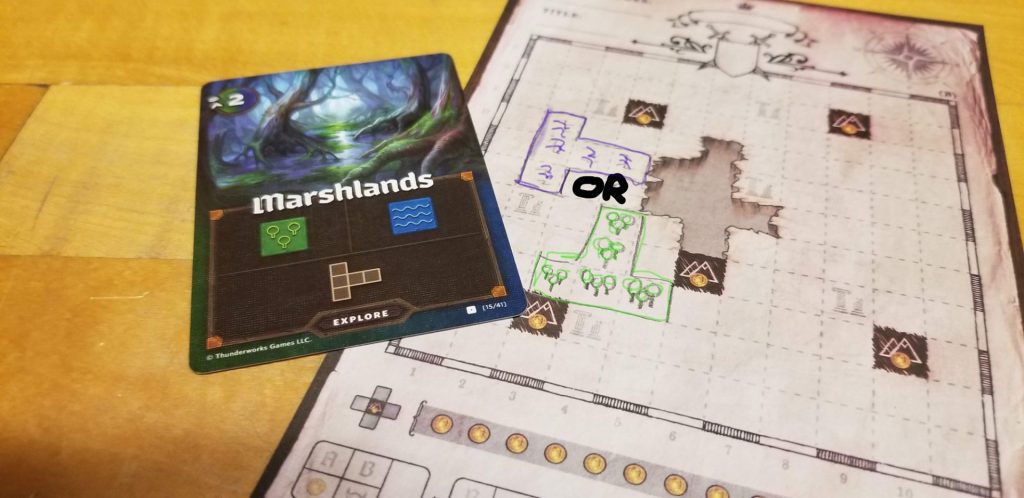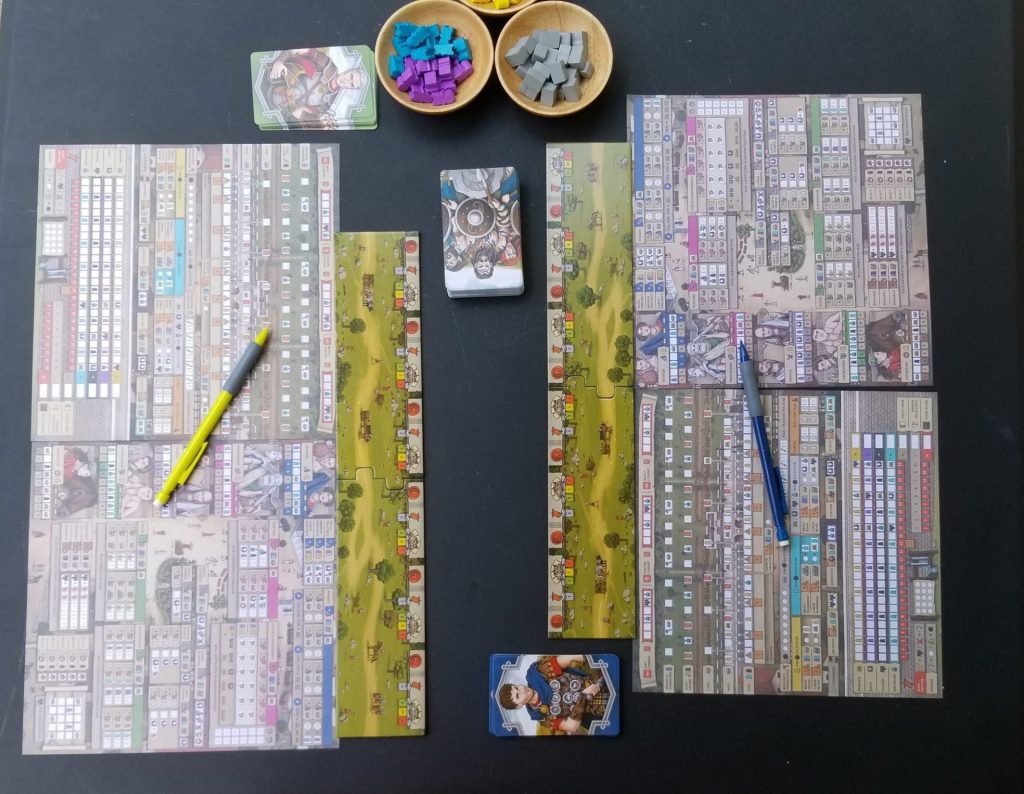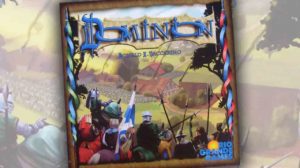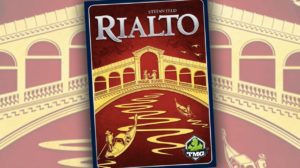In a previous Board Game Step Ladder article, we talked about Roll and Write games where the object is to roll some dice and then write down the resulting values in order to do something. It’s become a popular mechanic that has led to a lot of offshoots.
The subject of today’s article is one such offshoot, the Flip and Fill genre of games. While similar to Roll and Writes in many regards, the Flip and Fill uses randomly drawn cards to dictate and shape your actions. Dice present some limitations that cards simply don’t have. For one thing, dice are completely random and it is not uncommon for a dice rolling game to leave you with turns where nothing actually happens (Catan, for example). In a card based game, while randomly drawn, unless there are blank cards in the deck, you know that you’ll always get something even if it isn’t something you actually want. For another, a die can only display a single face at a time. So presenting a bevy of different options necessitates rolling more and more dice. A card, on the other hand, can achieve a lot more as you’ll soon see.
Silver and Gold > Cartographers > Hadrian’s Wall
Silver and Gold
Silver and Gold is a Flip and Fill game about pirates looking for treasure. Each player begins the game with two treasure map cards which are blocked off into a grid of differently arranged squares. During each round of play, one of the players will be flipping up a card from a deck of exploration cards. These cards depict a polyomino shape that the players must cross off on one of their two treasure map cards.
As players fill in their treasure map cards, they will begin earning bonuses after having crossed off specific features. For instance, if a player places an ‘X’ on top of a gold coin, then they cross off a gold coin on their score card. After crossing off four of these, they receive a trophy. These trophies decrease in value as players claim them, so it behooves a player to grab these trophies as quickly as possible. These gold coins are also worth one victory point each at the game’s end which provides further impetus to collect them.

There are several different types of bonuses that are just as valuable, so deciding where to draw in your shapes is never an easy decision. That being said, Silver and Gold is not a very difficult game. The rules can be taught in just a few minutes and the game plays lightning fast. It is an excellent introduction to the Flip and Fill genre, however, and that’s what lands it on this Step Ladder.
The next game on our list utilizes the Flip and Fill mechanic in a much more complex way by adding variable scoring conditions and a small dose of player interaction.
Cartographers
If you have played Silver and Gold (or any Flip and Fill game for that matter) then the concept of flipping over a card and using the information on it to fill in your player sheet will serve you well in Cartographers. In the game of Cartographers, the players are, well, cartographers trying to fill in the blank maps laying in front of them in such a way as to score more points than their opponents.
At the beginning of each game, a collection of four scoring cards are selected and placed into a row with each being assigned a letter (A, B, C, or D). The game is played over the course of four seasons and at the end of each season, a different set of scoring cards will be scored. At the end of Spring, for instance, cards A and B will be scored. Then cards B and C are scored at the end of Summer. Card A will not be scored again until the end of Winter. This creates an impetus to try to fill in your player sheet in such a way as to satisfy the scoring conditions not only for the cards you’ll be dealing with this round, but also for cards which you will encounter in the future. These scoring cards will give you points for things such as having certain features bordering other certain features, having large areas of the map filled in, having large blocks of the same feature, etc.
The features I am speaking of come from the deck of feature cards. During each season this deck is re-shuffled and cards are drawn from it. Each newly drawn card will display a number (used as a timer to signal when the current season is completed or nearing completion) as well as a feature (forest, villages, water, etc.) and a shape (or possibly even multiples of one or both of those). The players then have to choose one of the available features and one of the available shapes and then draw that feature/shape combination somewhere onto their player sheet.

In addition to the scoring already discussed, even more points can be earned by filling in the coin icons at the bottom of the player sheet. Coins are earned directly from some of the feature cards but can be earned by surrounding the mountains that come pre-printed on the player sheets as well. These points are cumulative. Each coin you earn is carried into the next round’s scoring and therefore the coins become worth even more points over time.
And then there are the monsters. Shuffled into the deck of feature cards each round will be one or more monster cards. When these come up, you’ll pass your sheet to one of your opponents and they will have the opportunity to draw the monster shape somewhere onto your sheet. Don’t fret, though. You’ll get to do the same to them, too. Not only do these monster shapes cause your opponents consternation because of how they disrupt whatever planned layout they were aiming for, each monster shape that isn’t totally surrounded is going to cost them a point during end-of-round scoring. Of course, the ones drawn onto your sheet will cost you points, too, if you don’t deal with them!
As you can see, there’s a lot more going on in Cartographers than Silver and Gold. If Silver and Gold is an exercise in reactivity, Cartographers is an exercise in proactivity. It’s an excellent step up the ladder and a good introduction to non-Flip and Fill games like Isle of Skye which use a similar scoring system. As far as Flip and Fills go, though, Cartographers isn’t nearly as complex as our next game.
Hadrian’s Wall
In Hadrian’s Wall, each player will take on the role of a Roman commander trying to build up and maintain one of the many milecastles along the eponymous Hadrian’s Wall, an ancient Roman structure that stretched clear across northern England. It’s a Flip and Fill game that will test you at every turn and have you both sighing in relief as your plans come to fruition and groaning in displeasure as they simultaneously fall apart. This game features a pair of different player sheets for each player that are jam packed with information, two different types of card decks —a public deck as well as a personal deck, and a massive amount of wooden meeples and resources in several different shapes and colors.
Each deck of cards is multi-use, serving different purposes depending on how the card is used. The common deck is used to dictate which resources each player receives at the beginning of the round, provides information that is used in conjunction with the player sheets during the round, or to determine what happens to the players at the end of the round. Except for the illustration on the card backs, each player card deck is identical. Each round a player must draw two cards, choose one for its resources and icons and choose another to add to their Path along the top of their player board. These Path cards provide end-of-game scoring criteria.
This emergent scoring criteria differs from the scoring in Silver and Gold and Cartographers in one major way: the scoring criteria is player driven and varies from player to player. This gives the players agency over what happens to them and, importantly, guidance to help them develop a strategy. And believe me, they’ll need guidance. At the beginning of a player’s turn, there are over 30 different actions to choose from.

The left side player sheet mostly deals with the actual construction of the wall: hiring workers to mine stone, training guards to ward off the attacking Picts, using the mined stone to build up the various aspects of the wall itself. Each of these actions requires specific combinations of workers and/or resources to perform. As each action is taken, boxes will be filled in to show your progress. And, like many games in this genre, some of those boxes have bonuses that, upon being covered up, will award the player with whatever the bonus is whether it be a free worker, a free resource, or something else.
The right side player sheet deals more with the workforce behind the construction and keeping them happy whether it be a trip to the market to buy things, going to the theater to take in a show, dabbling in politics, or following a more spiritual path. Each of the progress tracks on this sheet not only provide free resources and workers in the form of bonuses, but they unlock access to other actions the further you move along them.
Consider the Performers track, for instance. Filling in the first spot on this track unlocks access to the Theater. Building this moves you along one of the different victory point tracks (of which there are four) and allows you to trade in a stone, once per round, for the ability to fill in other boxes on other portions of your player sheets. Reaching the third level of the Performers track unlocks access to the Ludus Gladiatorus. After building that (and earning a free victory point for doing so), you’ll have the ability to train up gladiators and send them into battle (simulated by flipping a card from the common deck and checking for its gladiator value) in the quest for glory and even more victory points. And this is just one of the five different tracks on the right sheet.
As you can see, Hadrian’s Wall is an intricate tapestry of interconnected systems. This interconnectedness coupled with the player driven scoring lend the game a great deal of complexity and replayability. There’s definitely a learning curve, but once you understand how everything works, you’ll be glad you took the time to learn. Hadrian’s Wall is well worth the effort and it stands as a shining example of what is possible with the Flip and Fill mechanic.
Great things come from humble beginnings. From the easy to learn and play Silver and Gold to the brain burning Hadrian’s Wall, it’s clearly evident that the Flip and Fill genre can go almost anywhere and accomplish almost anything. We hope you’ve enjoyed your journey up the Step Ladder.
Is there something we should have left off? Something you think we should have added on? Let us know in the comments.











Add Comment